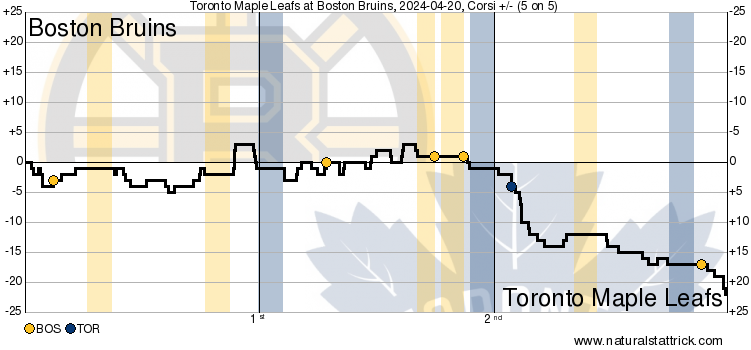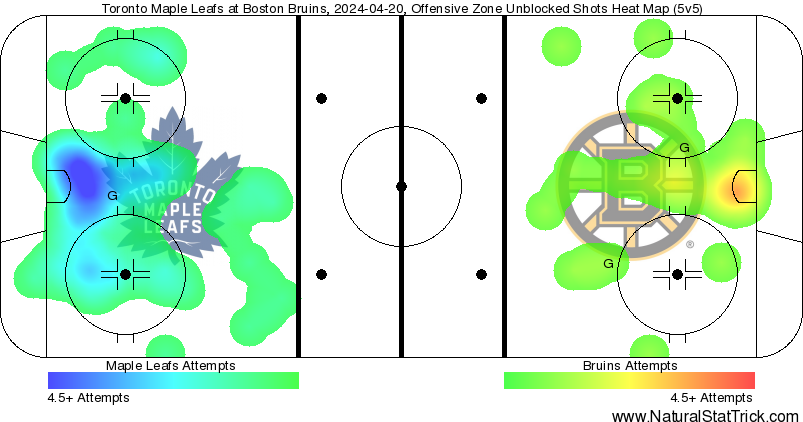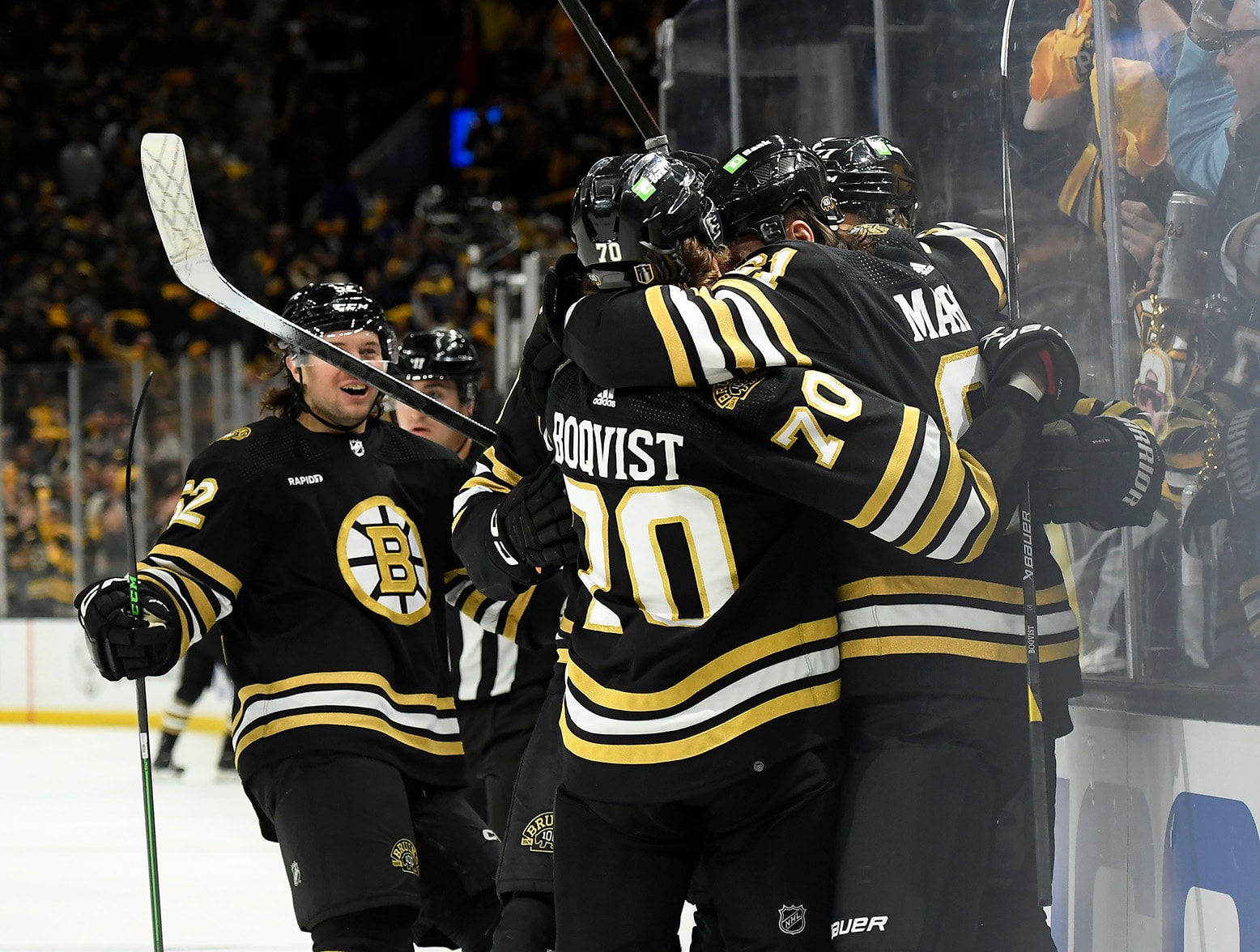Heading into this game, the Maple Leafs were 2-6 in Game 1s under this core. Make it 2-7.
There were a lot of familiar themes in this one, from poor special teams, to glaring defensive issues, to playing slow, to not scoring nearly enough yet again in the playoffs.
It’s too early in the series to reflect in the mirror, and the Leafs clearly need to get William Nylander back — and hopefully Bobby McMann — but this was an uninspiring start to the 2024 playoffs for the Leafs, to put it nicely.
Your game in 10:
1. The Leafs started this game with the Auston Matthews line, and the physicality was immediately evident. Max Domi slashed Brad Marchand before the puck even dropped. Once it did, the Leafs got the puck in deep, Tyler Bertuzzi laid a good hit on Brandon Carlo, and Domi broke his stick on Marchand. We noted in the pre-game that the Leafs would want to be physical but need to keep it in check. Their last game in Boston went off the rails with penalty issues, and it was the same deal more recently against the Panthers in Florida, where they made a point with their physical play.
The Leafs’ first few shifts of this game were positive, including a great chance for Nick Robertson. When the fourth line hit the ice, Ryan Reaves went out of his way to be physical. Joel Edmundson pinched down the wall on Pat Maroon, which is how the Leafs have played all season — the defenseman pinches up the wall, and the forward covers. Instead of covering, Reaves went for a double hit on Pat Maroon. Maroon took the hit to chip the puck out, and the Bruins went down on a 2v1.
Timothy Liljegren dove to attempt to take the pass away, but at this point, he needed to be aware of who had the puck. Jesper Boqvist has 34 goals in 236 NHL games. Liljegren has to make him shoot. Boqvist was dying to pass across; he did, and the Bruins buried it.
Ultimately, the Leafs brought in Reaves not just for his physicality but also for his veteran presence. It is highly disappointing that he started the first playoff game by getting caught up in the emotions instead of playing within the structure. This is the type of freebie goal against that has plagued the Leafs all season.
2. Just 2:26 into the game, the Leafs were already down 1-0, and the Bruins started building off the momentum. About three minutes after the goal, Simon Benoit was called for a hooking penalty that I would describe as generous. It was a big moment early in the game, down 1-0 with the building rocking, and the Leafs’ much-maligned penalty-killing unit needed to calm the game down.
For the most part, the Leafs’ penalty kill did a good job, pressuring the Bruins, preventing them from setting up easily, and making it difficult through the neutral zone. The Leafs ran out David Kampf—Mitch Marner as expected, and they kept the Boston top unit at bay.
The Leafs have recently deployed Matthew Knies on the PK; truthfully, I didn’t think too much about it at the time due to injuries, but here he was on the road in Game 1 of the playoffs seeing a regular shift on the unit. He didn’t drop low enough, and the Bruins connected on a cross-ice pass that hit the post. Later in the period, Charlie McAvoy also hit the post after an offensive-zone faceoff win where he shook off Tyler Bertuzzi and walked right in.
Besides the Robertson look before the Bruins scored, the Leafs’ best chance was probably a Domi pass to Matthews in the slot, but #34 fanned on the puck. The next best highlight might have been Connor Dewar driving the net for a whistle and grappling Andrew Peeke to the ice (Peeke has at least four inches on him).
Soon after, an errant high stick was called on Bertuzzi, but again, the Leafs’ penalty kill was generally solid. Again, though, the Bruins eventually broke them down, finding Pavel Zacha in the high slot, but Zacha hit the post. All things considered, it was another big kill.
After the penalty, the Bruins created a crazy scramble in front of Ilya Samsonov as Brandon Carlo tried to hit Trent Frederic at the backdoor; Timothy Liljegren did a good job tying him up, but the puck was available for others, and the Bruins got a few good whacks at it.
Afterward, the Leafs did create a few good chances. Most notably, Matthews had the puck twice in front of the net at the end of the period, but the puck bounced on him both times. With 10 seconds left, the play turned to 4v4 after a Domi and McAvoy exchange in front. At 4v4 to end the period, Matthews centered the puck to Marner, who looked like he was going to score, but he was crosschecked down for a penalty call, giving the Leafs a 4v3 to start the second period.
3. The 4v3 to start the second period was a pivotal moment in the game — a huge opportunity for the Leafs to tie it and put their poor start behind them. They created chances, but they didn’t convert. Matthews looked to make backdoor passes more than he looked to shoot, which was perhaps the most disappointing development of all (towards the end of the period, he also passed up a one-timer opportunity on the power play and tried another pass; he is a goal scorer who should shoot everything).
After the power play, Calle Jarnkrok took a stretch pass and went down alone, but he was robbed. Robertson was streaking, and Jarnkrok could have slowed down for a 2v1 or shot for a rebound, but he elected to shoot and came up completely empty.
Soon after, Matthews beat McAvoy in a race for a loose puck off a dump-in to the Leafs zone, catching Swayman out of his net going for the puck. While it was a tight angle and the play happened quickly, Matthews had enough time and space to shoot it into the net and instead hit the post. There were chances for the Leafs to tie the game, but they didn’t capitalize.
4. It felt like a goal was coming for the Leafs, but then they broke down at the other end. Two plays of note led to the breakdown before Brandon Carlo made it 2-0.
The first one was subtle; Morgan Rielly possessed the puck on his stick at the Leafs’ blue line with some time and space, but he elected for a high flip to the far blue line — essentially a free turnover for the Bruins (Tavares was open in the middle of the ice for a pass). The Bruins got the puck, put it deep, and it looked like the Leafs were going to break out just fine–the puck was on Matthew Knies’ stick with time and space, but he gave it away up the middle of the ice, and the Bruins took possession from there.
After a missed pass, the puck went to the corner, where Lindholm pinched down against Calle Jarnkrok while DeBrusk and Rielly pursued the puck. DeBrusk won the battle against Rielly and was free to skate around the net unscathed before laying an area pass that Carlo stepped into and hammered home.
Knies was plagued with these types of turnovers last playoffs as well, but he memorably scored right after one of them against Florida. That was not the case tonight.
5. Every time the Leafs attempted to push back, they shot themselves in the foot. One of the better chances in the second half of the period came when Domi walked in and ripped a shot high glove. The Leafs retained possession, and Bertuzzi took a spinning shot on net. As the Leafs held possession, Matthews was careless with his stick, high-sticking McAvoy. It was the Leafs’ second high-sticking penalty off the puck and their second offensive-zone infraction.
This time, the Leafs paid the price. The goal itself was simple enough; DeBrusk got the puck around the hashmark by the boards and was given all the time and space in the world to curl up at the top of the circle, walk down, and rip a shot. It’s not something we would ever see Boston allow Matthews to do.
In the series preview, we asked if the Leafs penalty kill was going to be aggressive enough — that’s when they’re effective instead of allowing teams to set up, take their time, and do as they please. The other big breakdown was much earlier in the play; the puck went behind the Leafs’ net to Ilya Lyubushkin, who had enough time and space to skate it around the net and possibly to the faceoff circle. Instead, he rushed a rim around the wall that the Bruins easily kept in, leading to the goal-scoring sequence.
6. Two and a half minutes after the Bruins scored a power-play goal, the Leafs took another needless penalty, this time Domi’s slash on Marchand. I am all for gamesmanship and some playoff mind games, but this has been a problem for the Leafs. Again, they looked far too busy attempting to prove they were physical and tough rather than simply playing the game while being physical and tough.
This time, the penalty kill did pressure the half-wall (Connor Dewar), but when the puck went up top to McAvoy as a result, instead of Matthew Knies pushing up, he skated to the other half-wall and pointed to Dewar to pressure, which made no sense. Dewar was already on the half-wall; he couldn’t possibly close that space, and he didn’t. McAvoy had all day to pick out his pass, finding Marchand in a down-low 2v1 (the Leafs have been deploying more of a diamond kill). Marchand saucered a puck to DeBrusk in tight, and while Samsonov got a piece of it initially, the goalie had no chance.
The tough reality is that Bobby McMann and William Nylander were penalty-killing staples, and without either of them, the Leafs needed someone to take the minutes. They went with Knies tonight, and it wasn’t smooth sailing.
7. The Leafs came out in the third period with some purpose. If nothing else, they needed to start building positive momentum they could feel good about and take into Game 2.
On the first few shifts, they got it. Matthew Knies laid a huge hit to start the period, and shortly afterward, Simon Benoit sifted a puck through from the point that Reaves tipped. It landed with Connor Dewar, who was battling in front, and Dewar made a nice pass to Kampf, who was crossing through the slot with an empty net to shoot into.
Kampf 1st of the Playoffs vs Bruins courtesy of @Bonsie1951 and @Jim_Ralph. @LeafsJelly pic.twitter.com/r3w3Yaj9XN
— Maple Leafs Hotstove (@LeafsNews) April 21, 2024
It was a nice fourth-line goal—the kind the Leafs need to create more of against this Bruins team: point shot, traffic, and a won battle. At the time of that goal, none of Liljegren, McCabe, Edmundson, or Lyubushkin recorded a shot on net for the Leafs. Rielly had one. Their point was a black hole with the puck, which we have discussed for years in this space.
8. The early goal gave the Leafs some legs. Shortly after Toronto made it 4-1, Benoit cranked a one-timer off the post. They strung together several good shifts, hemming the Bruins in their end, but they couldn’t push through for the second goal early enough in the period that it would have made it a game.
As the initial push subsided, the puck went down into the Leafs’ end, where Robertson was the first to the puck. He got stuffed up the wall instead of going cross-ice to a wide-open defenseman (and he was subsequently rocked after). The Leafs got hemmed in their end after that for over a minute, eventually leading to a penalty. The Bruins didn’t create much on this power play, but it really zapped the Leafs of any momentum they were building and settled the game down for Boston.
From there, the rest of the game was academic. The one standout down the stretch was the Leafs’ power play; they rightfully put out their top unit, and they didn’t even come close. By “didn’t even come close,” I mean they didn’t set up the zone. They were unable to enter the zone cleanly. They were pressured up ice and handled it poorly. The Bruins stood them up at their blue line, and they couldn’t break through it. Poor all around.
9. Most of the matchup game tonight was fairly straightforward. Auston Matthews went up against the Coyle line as expected, while John Tavares lined up against the Zacha line. Without William Nylander in the lineup, the Leafs didn’t have a third line that gave the Bruins much to think about—which was supposed to be the Leafs’ big advantage here—so the Bruins played it pretty straight up.
The only wrinkle came on defense. The Bruins used Lindholm-Carlo against Matthews primarily, while McAvoy went up against the Marner line. It neutralized the Leafs quite easily. It’s not just about Nylander’s absence; Bobby McMann was a real revelation this year as a goal scorer and top-nine player.
The Leafs have little chance to win this series without their scoring depth coming through. They need to hang their hat on their scoring; not only did it not happen tonight, but this is the eighth straight playoff game with two or fewer goals scored. We can break it down any way we’d like, but ultimately, the stars need to be the stars. It’s how every team in the league’s history has won a Cup. A team will never win in spite of its stars.
10. For a team that talked a lot about toughness and clearly was going out of their way to demonstrate it in this game, the Leafs ended the night with a whimper. They did not mix it up all down the stretch, and while they did throw hits throughout the game (and were generally physical), they more or less lied down as the game ended.
We talked about Ryan Reaves making a bad play to start the game, and his rough night only compounded as it went on, in my view. Pat Maroon picked up an assist, ran Liljegren into the Bruins bench, and threw a number of bone-crunching hits. He was a real factor. Reaves, on the other hand, was barely noticeable from a physical standpoint, and while he did pick up an assist on the team’s only goal, he didn’t address Maroon at any point as he ran around all game.
Beyond the physicality angle, it also stood out how slowly the Leafs played. Alec wrote about this last spring. Lots of regrouping. A lack of willingness to dump a puck and get it back. They didn’t gain enough speed through the neutral zone and actively slowed down instead of driving the net off the rush. On one play in the second period, Marner held the puck along the wall, and Tavares streaked through the middle of the ice with a chance for an odd-man rush. Instead of Marner racing down the ice with speed to put the Bruins on their heels, he slowed up and tried to saucer a puck past Matt Grzelcyk, who easily batted the puck down and moved it back up ice.
The Leafs can’t play slow in the playoffs. The checking is too tight.
Game Flow: 5v5 Shot Attempts

Heat Map: 5v5 Shot Attempts































![New Leaf Anthony Stolarz on the opportunity in Toronto: “In Florida, I knew my role as a backup… Now, [Joseph Woll] and I are competing for starts… As a goalie, that’s all you can ask for” Anthony Stolarz, Stanley Cup win, now Maple Leaf](https://mapleleafshotstove.com/wp-content/uploads/2024/07/anthony-stolarz-sc-100x70.jpg)
